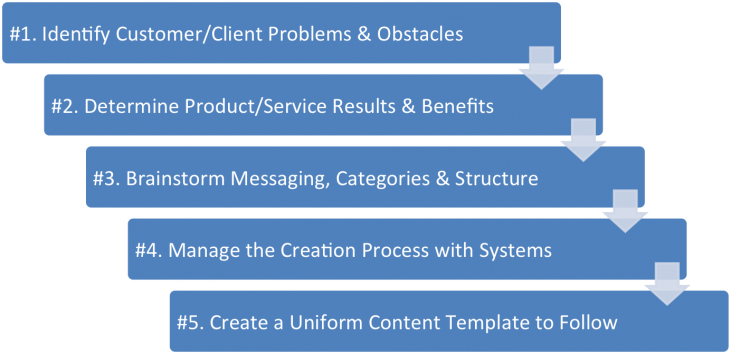You need to create content that’s unique-enough to create thought-leadership and compel organic sharing, but also make it relevant-enough to improve key marketing and business metrics.
Five steps to developing a content marketing strategy:

Step #1: What are Your Customer’s Problems and Obstacles?
The best business content is focused on addressing your customer’s problems, while positioning (explicitly or implicitly) your company, product and service as the solution.
What’s in it for them? Why should people need your widget at all?
The best way to get this information is straight from the customers themselves. Start with short surveys that ask people what their main objectives are and what’s stopping or preventing them. Then follow up personally to dig deeper and find out their existing process for improvement, or other struggles they’re experiencing.
Step #2: What are Your Product Results and Benefits?
People don’t purchase features or deliverables — they’re purchasing an outcome or end result.
Start by thinking about what customers/clients will get after using your product or service. More often than not, there will be many answers to this question.
The key here is to be as specific as possible. Don’t stop at the general cliches like “waste time and money”, because that’s what everyone else says. And the more potential customer segments you have, the vastly different motivators you’ll need to uncover.
Step #3: Determine Your Messaging, Categories and Structure
These categories relate to how your product specifically improves customer’s lives. And it establishes thought leadership while improving your brand positioning without directly referring to your product.
- Test specific information (including common problems and frequently asked questions)
- Life hacks (i.e. getting outsized results in studying, applying, productivity, etc.)
- School/student life (to reach customers earlier in the lifecycle)
- Proprietary data and research (that no competitor can claim or reproduce)
- Business origin and product vision (so we can start with why)
- Misc. product updates and events (to keep people up-to-date on improvements).
Step #4: Manage the Creation Process
You need a fluid, flexible way to keep track of new topic ideas, responsibility and projected dates.
Step #5: Create a Uniform Content Template
Here are some of the essential ingredients to each piece of content:
- Headline: Play on psychology to capture attention by using a Headline Hack (threat, how-to, mistake, or list)
- Hook/Lead: Build interest and anticipation through using an anecdote, intrigue , a surprising fact or humor.
- Problem / Context: Explain common problem to create resonance and address underlying or unexpected issues involved
- Solution: Provide solution to root cause and relieve tension
- Conclusion / Wrap-Up: Highlight key takeaway, summarize main points, provide actionable tip, or use a call-to-action
Keep paragraphs shorter than 5 sentences, and don’t be afraid to write informally with simple words.
Source: moz.com/ugc/case-study-5-steps-to-create-a-killer-content-marketing-strategy